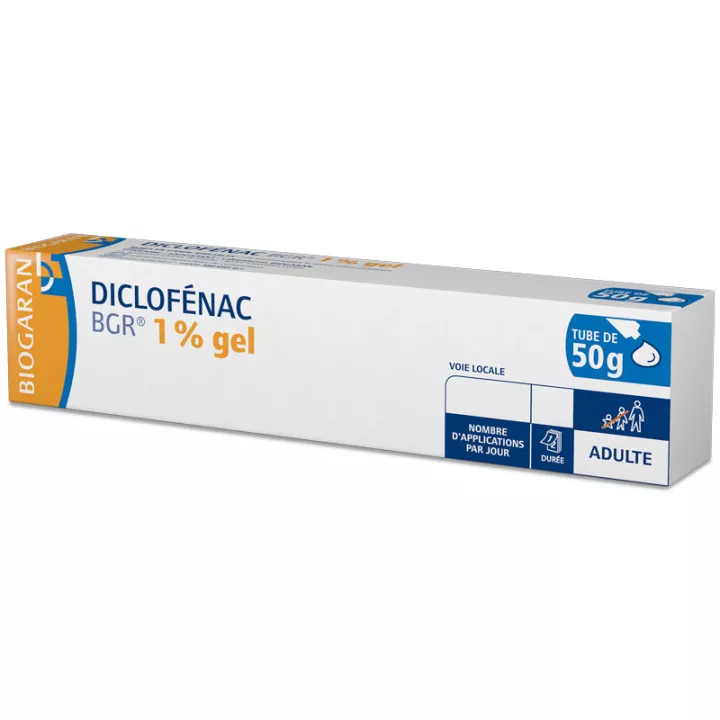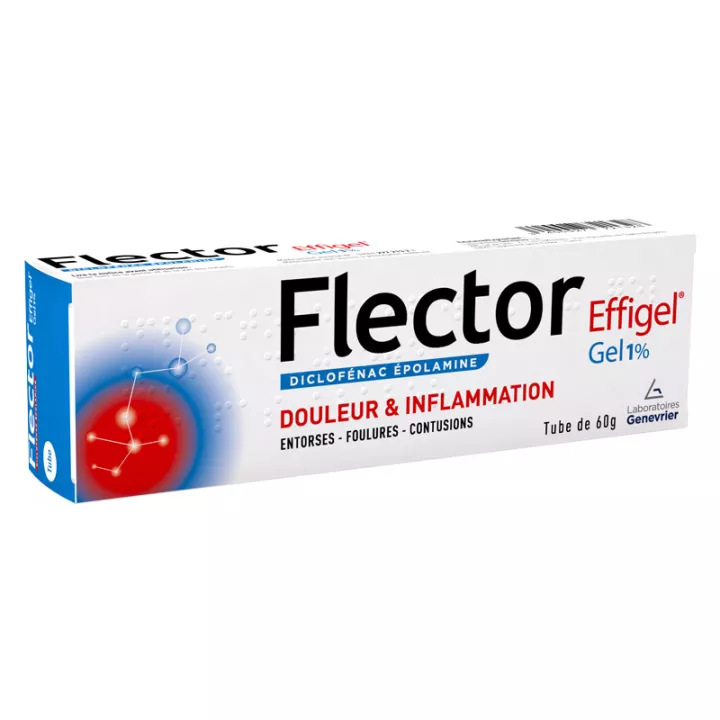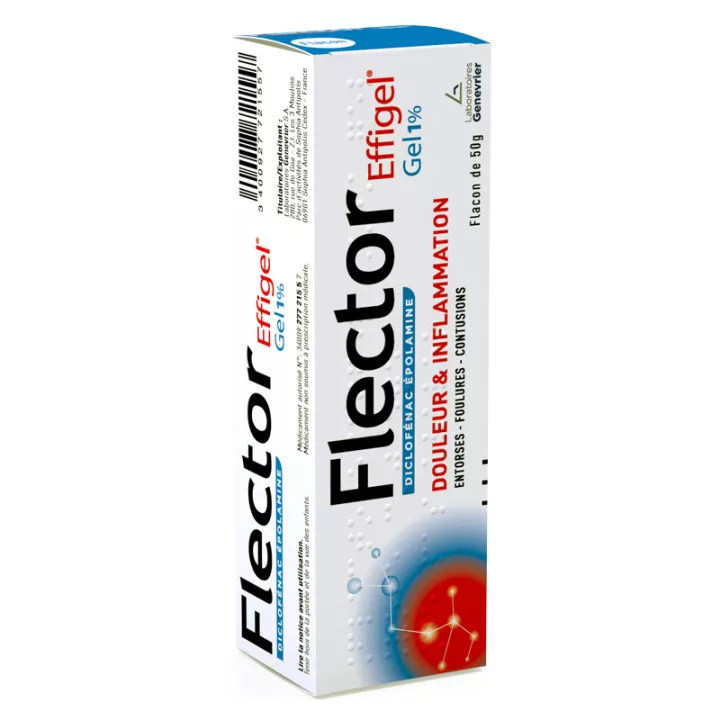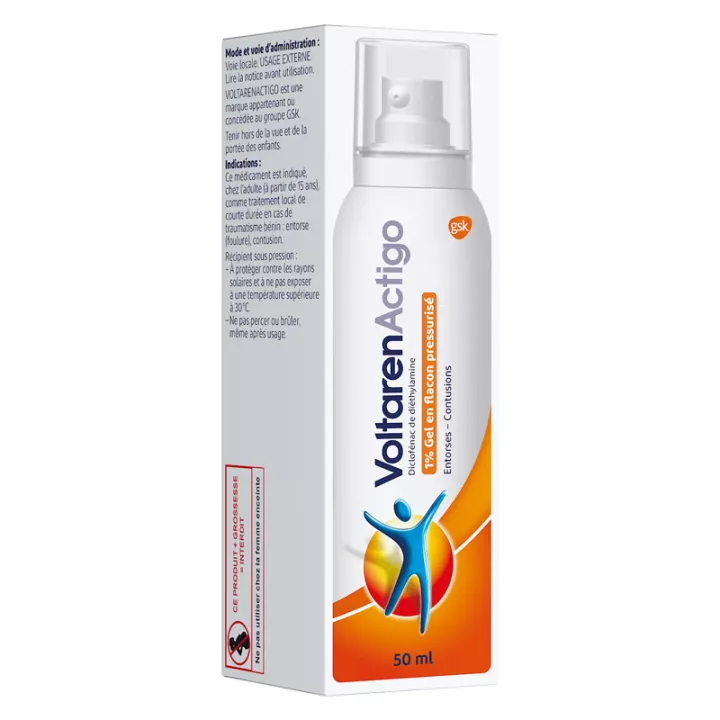NOTICE
ANSM - Last updated: 06/04/2017
Name of the medicinal product
DICLOFENAC BGR 1%, gel
diclofenac
framed
Please read this leaflet carefully before you start using this medicine because it contains important information for you.
You should always use this medication exactly as prescribed in this leaflet or by your doctor, pharmacist or nurse.
· Keep this leaflet. You might need to read it again.
· Ask your pharmacist for advice or information.
· If you experience any side effects, talk to your doctor, pharmacist or nurse. This also applies to any side effects not mentioned in this leaflet. See section 4.
You should contact your doctor if you do not feel better or feel less well:
o after 4 days in case of benign trauma: sprain (bruising), contusion,
o after 7 days in case of pain of muscular origin and tendino-ligament,
o after a maximum of 14 days in case of a painful outbreak of osteoarthritis.
What is in this leaflet?
1. What is DICLOFENAC BGR 1%, gel and when is it used?
2. What should I know before using DICLOFENAC BGR 1%, gel?
3. How to use DICLOFENAC BGR 1%, gel?
4. What are the possible side effects?
5. How to store DICLOFENAC BGR 1%, gel?
6. Package contents and other information.
1. WHAT DICLOFENAC BGR 1%, gel AND WHAT IT IS USED FOR?
Pharmacotherapeutic group - ATC code: M02AA15.
This medication is an anti-inflammatory and an analgesic (it calms the pain), in the form of gel for application on the skin, only in the region of pain.
This medication is intended for adults (from 15 years), for a short time, in:
· local treatment in case of benign trauma: sprain (bruising), contusion;
· local topical treatment of muscle and tendon-ligament pain;
· the symptomatic treatment of painful relapses of osteoarthritis, after at least a medical opinion.
2. BEFORE YOU USE DICLOFENAC BGR 1%, freezing?
Do not use DICLOFENAC BGR 1%, gel:
· from the 25th week of amenorrhea (beginning of the 6th month of pregnancy);
· in the event of an allergy to this or a related drug, including other non-steroidal anti-inflammatory drugs, aspirin;
· in case of allergy to any of the excipients;
· on injured skin, whatever the lesion: oozing lesions, eczema, infected lesion, burn or wound;
· in children under 15 years of age.
IN CASE OF DOUBT, IT IS ESSENTIAL TO ASK FOR THE OPINION OF YOUR PHYSICIAN OR YOUR PHARMACIST.
Warnings and Precautions
Talk to your doctor, pharmacist or nurse before using DICLOFENAC BGR 1%, gel.
· Do not apply on mucous membranes or eyes.
· The appearance of a rash after application requires immediate cessation of treatment.
· Do not apply over large areas of skin and for prolonged periods without medical advice.
· This medicine contains propylene glycol and may cause skin irritation.
The gel form is reserved for adults (from 15 years).
In adolescents aged 15 years and older, if symptoms worsen, it is recommended to seek the advice of your doctor.
The use of gloves by the masseur physiotherapist, in case of intensive use, is recommended.
IN CASE OF DOUBT DO NOT HESITATE TO REQUEST THE NOTICE OF YOUR DOCTOR OR PHARMACIST.
If you are pregnant or breastfeeding:
Do not use this medication on your own. Seek advice from your doctor or pharmacist
Children and adolescents (under 15 years of age):
This medication should not be used in children younger than 15 years of age (see section "Never use DICLOFENAC BGR 1%, gel in the following cases").
Other medicines and DICLOFENAC BGR 1%, gel
Inform your doctor or pharmacist if you are using, have recently used or could use any other medicines.
This medicine contains Diclofenac. Other medicines contain certain medicines taken orally. Do not combine them, so as not to exceed the maximum recommended doses (see Dosage and Administration). |
DICLOFENAC BGR 1%, gel with food, drinks and alcohol
Not applicable.
Pregnancy and breast feeding
If you are pregnant or breastfeeding, think you may be pregnant or plan a pregnancy, ask your doctor or pharmacist for advice before taking this medicine.
Pregnancy
DICLOFENAC BGR 1% Gel should not be used from the 25th week of gestation (early 6 th month of pregnancy), as it could have adverse effects on the fetus or cause problems with childbirth. DICLOFENAC BGR 1% Gel should be used only after medical advice until the 24th week of amenorrhea (5 months of age pregnancy) and the dose should be as low as possible and the length of the shortest treatment .
feeding
This drug passes into breast milk in small amounts. During breast-feeding, DICLOFENAC BGR 1%, gel should only be used after medical advice. However, DICLOFENAC BGR 1%, gel should not be applied to breasts in breastfeeding mothers, on a large skin surface, or for a prolonged period.
Driving and using machines
Not applicable.
DICLOFENAC BGR 1%, gel contains propylene glycol.
This medicine contains propylene glycol and may cause skin irritation.
3. HOW TO USE DICLOFENAC BGR 1%, gel?
Always use this medication exactly as prescribed in this leaflet or as directed by your doctor, pharmacist or nurse. Check with your doctor, pharmacist or nurse if in doubt.
Dosage and duration of treatment
Reserved for adults (from 15 years).
The dosage depends on the indication.
The occurrence of adverse reactions can be minimized by using the lowest dose possible during the shortest treatment time needed to relieve symptoms.
Benign trauma: sprain (bruising), contusion
1 local application, 2 to 3 times a day, for a maximum duration of 4 days. If the pain persists beyond that, a doctor should be consulted .
The dose administered to each application should not exceed 2.5 g of gel. This maximum dose corresponds to a tape of 6 cm of gel (see diagram of the scale) .

|
Pains of Muscular and Tendon-Ligament Origin In supplementary treatment: 1 local application, 3 to 4 times per day, for a maximum duration of 7 days. If the pain persists beyond that, a doctor should be consulted. The dose administered to each application should not exceed 2.5 g of gel. This maximum dose corresponds to a 6 cm ribbon (see scale drawing). |
 |
Painful outbursts of osteoarthritis Only after a first medical opinion. Symptomatic treatment: 1 local application, 3 to 4 times per day, for a duration of 7 days. Treatment may be continued, if necessary, for up to 14 days. If the pain persists beyond that, a doctor should be consulted. The dose administered to each application should not exceed 4 g of gel. This corresponds to a ribbon of about 10 cm (see diagram to scale). |
 |
Special Populations
Children and adolescents under 15 years of age
This medication should not be used in children and adolescents under 15 years of age (see section "Never use DICLOFENAC BGR 1%, gel").
Elderly
This medication should be used with caution in elderly people who are more prone to adverse effects (see sections 4.4 and 4.8).
Administration mode
Local track.
Allow the gel to penetrate through a gentle and prolonged massage on the painful or inflammatory area.
Wash hands thoroughly after each use (except in the case of painful arthrosis of the fingers, if you apply the product to yourself).
If you have used more than 1% DICLOFENAC BGR, you should not have
In case of overdose or accidental poisoning, rinse thoroughly with water and consult your doctor or pharmacist immediately.
If you forget to use DICLOFENAC BGR 1%, gel
If you have accidentally forgotten a dose, wait for the next dose and continue your treatment normally. Do not take a double dose to make up for a missed dose.
If you stop using DICLOFENAC BGR 1%, gel
Not applicable.
If you have any further questions on the use of this medication, ask your doctor, pharmacist or nurse for more information.
4. WHAT ARE POSSIBLE SIDE EFFECTS?
Like all medicines, this medicine may cause side effects, although not everybody gets them.
Exceptionally severe reactions may occur:
· allergic skin reactions: rash, urticaria, bullae,
· respiratory problems such as asthma attack (noisy and short breath, decreased breathing ability);
· general manifestations of anaphylaxis (swelling of the face, lips, tongue, throat).
Immediately stop taking the medication and tell your doctor or pharmacist.
More commonly, adverse effects can occur, usually mild and transient:
· local skin effects such as redness, itching, skin irritation, local eruption or ulceration,
· very exceptionally, an increase in sensitivity to the sun,
· other general effects of non-steroidal anti-inflammatory agents, depending on the amount of gel applied, the surface area treated and its condition, duration of treatment and whether or not a closed dressing is used.
You should tell your doctor or pharmacist.
Declaration of side effects
If you experience any side effects, talk to your doctor, pharmacist or nurse. This also applies to any side effects not mentioned in this leaflet. You can also report adverse reactions directly via the national reporting system: National Agency for the Safety of Medicines and Health Products (ANSM) and network of Regional Centers of Pharmacovigilance - Website: www.ansm.sante.fr
By reporting adverse reactions, you are helping to provide more information about the safety of the drug.
5. HOW TO STORE DICLOFENAC BGR 1%, gel?
Keep this medicine out of the reach and sight of children.
Do not use this medicine after the expiry date which is stated on the carton. The expiry date refers to the last day of that month.
No special storage conditions.
Do not throw any medicines into drains or rubbish. Ask your pharmacist to remove any medications you are no longer using. These measures will help protect the environment.
6. PACKAGE CONTENTS AND OTHER INFORMATION
What DICLOFENAC BGR contains 1%, gel
· The active substance is:
Diclofenac diethylamine ............................................... .................................................. 1.16 g
Quantity corresponding to diclofenac sodium ............................................. .......................... 1.00 g
For 100 g of gel.
· The other components are:
Diethylamine, carboxy 974 P, caprylic and capric acid ester, isopropyl alcohol, liquid paraffin, propylene glycol, polyethylene glycol 1000, purified water.
What is DICLOFENAC BGR 1%, gel and contents of the pack
This medication is in the form of a gel in 50 g tube.
Marketing Authorization Holder
BIOGARAN
15, BOULEVARD CHARLES DE GAULLE
92700 COLOMBES
Marketing Authorization Operator
BIOGARAN
15, BOULEVARD CHARLES DE GAULLE
92700 COLOMBES
Maker
CONTRACT PHARMA MANUFACTURING GMBH
FRUHLINGSTRASSE 7
D-83620 FELDKIRCHEN-WESTERHAM
GERMANY
Names of the medicinal product in the Member States of the European Economic Area
Not applicable.
The last date on which this leaflet was revised is:
[to be completed later by the holder]
Other
Detailed information on this medicine is available on the ANSM website (France).
ADVICE / HEALTH EDUCATION
Caution: Regardless of the indication for which you are using this medication, if there is a complete functional impotence, ie if you can not use the limb and in case of a significant "blue" hematoma, you should consult your doctor without delay .
Benign trauma: sprain (bruising), contusion
You just have trauma or bruising, you can use the gel for up to 4 days to relieve your pain. Do not resume a sporting activity or intense physical practice before the complete disappearance of the pain.
In addition, in case of:
Ankle sprain
You should consult your doctor who will judge the need for x-rays and orthopedic treatment:
· if you absolutely can not put yourself in support on the leg to make four steps,
· or if a hematoma (blue) appears within 24 to 48 hours,
· or if there is a considerable distortion or edema (swelling).
Injury of the knee
You should consult your doctor who will judge the need for x-rays and orthopedic treatment:
· in the event of severe swelling of the knee, with or without hematoma,
· and / or in case of impossibility of support.
Pains of Muscular and Tendon-Ligament Origin
If you can not use the limb that hurts you, or if the pain persists for more than 7 days, you should see a doctor.
Painful thrust of osteoarthritis
Osteoarthritis should be diagnosed by a doctor, who alone can make a difference with other diseases.
You can use this medicine to relieve the pain associated with a flare-up of osteoarthritis. However, you should consult your doctor without delay:
· if the pain lasts more than 14 days,
· or if the pain appears rather at night,
· or if it is accompanied by redness, rash, swelling, fever, discomfort or pain.











